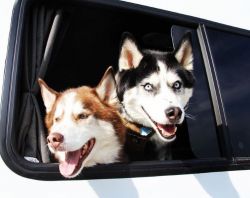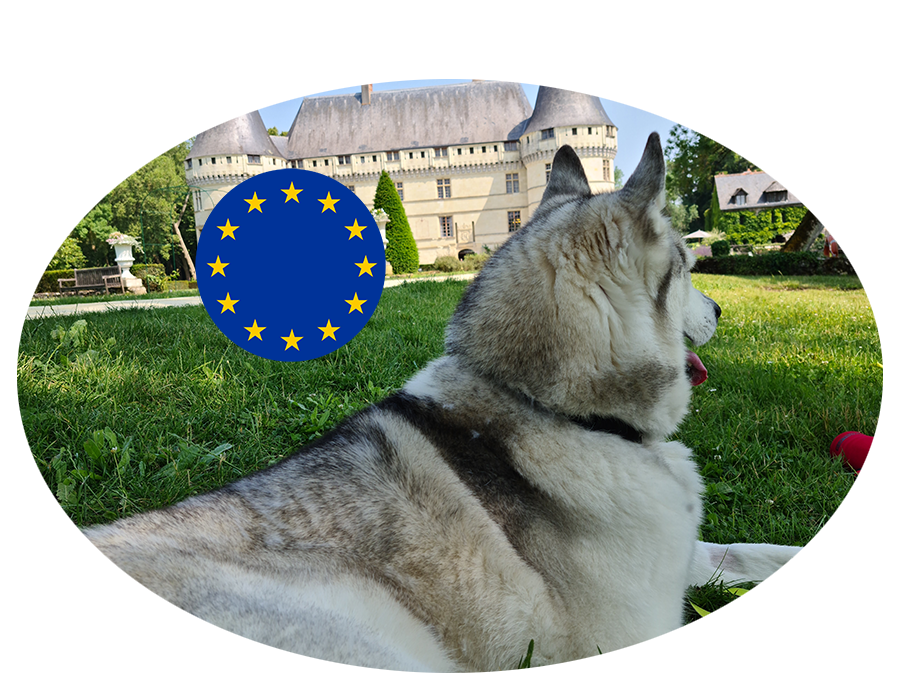
Check this first before considering your trip
Embarking on my very first journey into Europe, it quickly became crystal clear that our holidays were taken up a notch with the addition of my trusty companion, Mia – a friendly Siberian Husky. She might not be the tiniest of dogs, but her friendly nature makes up for it.
Now, before we dive into the wonderful world of traveling with your four-legged friend, here's a heads-up: the very first thing you must do is check if your dog's breed is on the list of banned breeds. It doesn't matter how pampered your pooch is – if they're on that list, they won't be allowed to join the adventure.
With that important piece of information tucked away, let's explore the pros and cons of having your furry buddy as your travel buddy. It's amazing how much they can enhance the journey – from offering companionship during solo drives to adding a touch of homey comfort wherever you go. So, whether your dog is a pint-sized pug or a majestic mastiff, there's a lot to consider when bringing them along on your motorhome escapades.
Also make certain that you have carried out the medical requiresments below or advised by your vet. Read on.
Feel free to bring your furry family members along with you
-
Taking your pet
- If you're considering bringing your furry friend to an EU Country post-January 1st, 2021, there's crucial information to ensure your travel plans go smoothly for both you and your pet.
- Pre-Travel Preparations: Before embarking on your journey, especially with your dog, cat, or ferret, you'll want to begin these steps at least four months ahead of your intended travel date:
- Microchip: Ensure your pet is microchipped, a necessary identification measure.
- Rabies Vaccination: Your pet needs to be vaccinated against rabies. Note that your pet must be at least 12 weeks old before receiving this vaccination.
- Blood Sample: Following the primary rabies vaccination, arrange for a blood sample to be taken at least 30 days later. This sample will be sent to an EU-approved blood testing laboratory.
- Waiting Period: After the successful blood sample, there's a mandatory three-month waiting period before your pet can travel.
- Animal Health Certificate (AHC): Once your pet's blood sample is cleared, your vet will provide you with a copy of the test results and create an Animal Health Certificate (AHC) that includes the day the blood sample was collected.
- Travel Restrictions: Your pet can only travel if you possess a valid Animal Health Certificate. Unfortunately, without it, your pet won't be allowed to accompany you.
- Unsuccessful Blood Test Result:
- If your pet's blood test doesn't meet the requirements, a re-vaccination and another blood test after an additional 30-day wait will be necessary.
- Future Travels to the EU:
- As long as your pet's rabies vaccinations are kept current, you won't need to redo blood tests for subsequent trips to the EU. However, every time you travel, make sure to obtain an Animal Health Certificate (AHC) from your vet within 10 days before departure.
By adhering to these guidelines, you can ensure a safe and enjoyable journey for your pet within the EU.
-
Returning with your pet
- Bringing your dog back to the UK from EU country involves adhering to the Pet Travel Scheme (PETS) rules. Please note that regulations might have changed since writing this, so I recommend verifying the most current requirements with the official government sources or a veterinarian. As of September 2021, the following general guidelines apply:
- Microchip: Your dog must be microchipped with an ISO 11784/11785 compliant 15-digit pet microchip. This microchip ensures proper identification.
- Rabies Vaccination: Your dog needs a valid rabies vaccination. Ensure the vaccination is administered after the microchip has been implanted. Your pet should be at least 12 weeks old before getting vaccinated.
- Pet Passport or Health Certificate: Your dog will need an EU pet passport issued by an official veterinarian or an official third-country health certificate. This document confirms that your dog has been microchipped, vaccinated against rabies, and is in good health.
- Tapeworm Treatment: If you're traveling to the UK from a listed tapeworm-free country (which includes most EU countries), your dog will need to be treated against tapeworm using an approved product 24 to 120 hours before arriving in the UK.
- Blood Test (if applicable): If your dog is traveling from an "unlisted" country, it may need a blood test to demonstrate sufficient rabies antibody levels. The blood test must be taken at least 30 days after the rabies vaccination.
- A Wait Period: There's a minimum 21-day waiting period from the date of the successful rabies vaccination or blood test (if applicable) before traveling to the UK.
- Approved Route: Your dog must travel into the UK on an approved route and with an approved transport company.
Your Pet Travel Companion: Guidelines for a Safe Journey
We understand that embarking on a journey with your beloved pet is an adventure like no other. As pet enthusiasts, we're here to offer you a roadmap for a safe and joyful travel experience. However, it's essential to remember that the guidelines provided above were accurate at the time of writing.
- Stay Current: The world of pet travel is dynamic, with regulations and recommendations subject to change. Before you set off on your adventure, we strongly advise you to consult your veterinarian and research the latest government guidelines for pet travel at your intended destination.
- Partner with Professionals: Your veterinarian is your best ally in ensuring your pet's health and comfort during travel. They can provide personalized advice and recommendations based on your pet's unique needs.
- Adapt and Adjust: Government guidelines can evolve to reflect changing circumstances. It's your responsibility as a conscientious pet owner to stay informed about any updates that might affect your pet's travel plans.
- Always consider the best time to go knowing that your furry friend may not appreciate going when the weather is to hot and you could easily kill your companion
- If possible, take their food and treats which are normally given to them with you. A change of diet might not be the best time well traveling in a motorhome.
- Often, it's useful to take some basic tools, tick remover, flea shampoo and in some areas anti sandfly collars.
- If you do plan on leaving your dog, cat etc in your motorhome, always consider the temperature and leave them water even on what you would consider a normal day. Try to consider how stressful this is for them and keep it to a minimum. If you are planning on doing it, you might want to do short sessions to get them used to it and so they learn that you will be returning home, but similar to being at home, try to avoid it when possible and certainly no more than a few hours
By taking these proactive steps, you're demonstrating your commitment to being a responsible and caring pet owner. Your dedication not only safeguards your pet's well-being but also contributes to the overall happiness of your journey together.
For any questions or concerns, feel free to reach out to us. Safe travels for you and your furry companion!
Reasons to not leave them behind
I'm a firm believer that our furry companions are basically the four-legged wing of our family. And guess what? When you're out and about in your motorhome, they can dodge the whole "staring sadly through the kennel bars" routine when you jet off on those vacation escapades. I mean, can you blame them? Kennels are like the doggy equivalent of leaving them in a horror movie marathon.
But let's not forget the human side of this drama. Leaving your pupper behind can transform even the toughest owner into a puddle of separation anxiety. It's like sending your heart on vacation without the rest of you. And who needs that kind of stress, right?
Instead, picture this: you, your trusty motorhome, and your furry co-pilot. No holiday FOMO for your doggo. They're there for the scenic strolls, providing top-notch security (who's gonna mess with a motorhome guarded by a fluffy barking machine?), and offering up some serious navigational commentary while you drive.
Oh, and the social game? On point. Suddenly, your motorhome is the talk of the campground. Everyone wants to know who's lucky enough to have that tail-wagging, adventure-loving fluffball inside. It's like having a celebrity on board. Move over, Brad Pitt.
And don't even get me started on the pet selfies. You've got the ultimate Instagram model right there, ready to strike a pose against breathtaking backdrops. It's like your dog was born for the camera – move over, supermodels!
So, there you have it. Ditch the kennel drama, bring your fur baby on your getaway, and watch your holiday transform into a pet-infused adventure. It's a win-win: you get a stress-free trip, your pup gets an epic vacation, and together you'll write the next chapter of your hilarious motorhome memoirs.



